You probably know that the deadlift is one of the best exercises you can do for gaining whole-body strength and muscle.
It works everything you want to grow if you want to look strong–your traps, lats, forearms, and thighs–as well as “beach muscles” like the biceps and abs.
There are quite a few ways of going about deadlifting, though, and in this article we’re going to tackle a hotly debated topic:
The deadlift grip.
This is an important discussion for a couple reasons.
1. One of the main reasons people stall in their progression on the deadlift is grip weakness.
You can develop a posterior chain that can pull hundreds of pounds, but if your grip doesn’t keep up, you’ll never actually get there.
Thus, progressively building your grip strength and evolving your technique are important parts of maximizing your deadlift performance.
2. Getting your grip right can reduce your risk of injury.
When your grip starts to fail, it’s tempting to compromise your form to keep the bar moving.
You know, rounding your lower back, shooting your hips up ahead of the shoulders, trying to shrug the weight up, and so forth.
These shortcuts are dangerous, and especially as you move into heavier weights, when your grip is most likely to flounder.
Now, if you’ve done any studying on the subject so far, you know that you have four options for your deadlift grip:
- Double overhand grip
- Double overhand grip with straps
- Mixed grip
- Hook grip
What’s the best grip setup for you, though? And how should it change over time and why?
Well, you’re going to get answers to those questions and more in this article.
In it, we’re going to break down the basics of proper gripping, the pros and cons of each style of deadlift grip and how to find which is going to be best for you, the best types of straps and equipment, and more.
Let’s start at the top…
Table of Contents
Deadlift Grip 101
Before we talk about the different deadlift grips, let’s talk fundamentals.
Specifically, there are three simple rules for the gripping that will improve your performance regardless of what style of grip you’re using.
Grip the bar with your fingers, not your palms.
A common deadlift grip mistake that people make is gripping it in their palms, closer to their wrist.
This might feel secure when you’re getting set up, but once you start to ascend, the bar will slide into your fingers, throwing off your balance, form, and tempo.
The right way to set up your deadlift grip, then, is to start with the bar in your fingers, like this:
This way, the bar stays locked in place throughout the entire movement, allowing you to focus on the gross motor movements.
Squeeze the bar as hard as you can every single rep.
One of the easiest ways to increase your strength on just about any barbell exercise is to simply grip the bar like your life depends on it.
There’s a reason powerlifters think about “bending the bar in half” when bench pressing and “digging finger grooves” into it when pulling.
They want their knuckles white for each and every rep because it helps prevent the bar from rolling out of their hands and increases force production.
Pull every rep with good form.
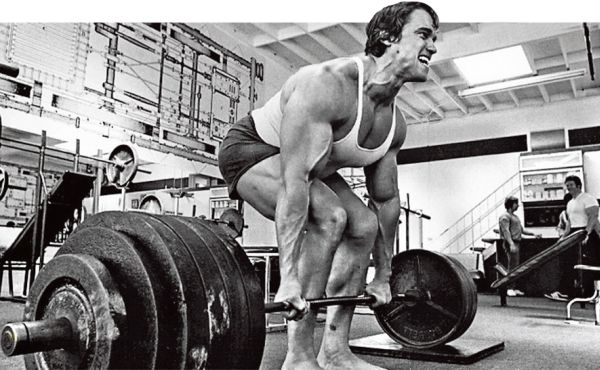
You can accurately describe the deadlift as “picking a barbell up and putting it down,” but it’s far more technical than many people realize.
It requires a carefully coordinated sequence of actions and positions, and if you veer off course at any point, you make it much harder on your entire body, including your grip.
Poor form can compromise your grip by placing you at a biomechanical disadvantage and unnecessarily increasing the time that the bar must remain in your hands.
Getting this right starts with a proper deadlift setup— with your shoulders over or slightly in front of the bar and your lumbar spine in a neutral position, allowing you to pull the bar up in a more or less straight line.
Here’s what I’m talking about:
Notice how the bar starts a couple inches in front of his shins, how his shoulders and hips are aligned, and how the bar doesn’t waver to or fro as he pulls?
That’s how you deadlift with maximum efficiency and thereby mitigate the amount of work that your grip has to do and the extent to which it can get in the way.


The 4 Deadlift Grips That You Need to Know
Most people think that the deadlift grip is all about raw grip strength.
If you can’t keep the bar from rolling out of your hands, they say, then you just need stronger hands and forearms.
Well, that’s certainly a limiting factor, but grip technique can also hold you back, and especially if you’re an intermediate or advanced weightlifter.
In the beginning, you don’t have the whole-body strength to give your grip more than it can handle, but once you’ve put in a year or so of hard work, the game changes.
At that point, your grip technique becomes just as important for the purposes of safety and progress as maintaining a neutral spine, coordinating your hips and shoulders, and maintaining a straight bar path.
So, with all that in mind, let’s look at the four kinds of deadlift grips that you need to know about, starting with the one you’re probably most familiar with.
Double Overhand Grip
If you walk up to a barbell, reach down, and grab it in the way that feels most natural, chances are you’ll wind up with a double overhand grip.
This is also called a “pronated grip,” and it looks like this:
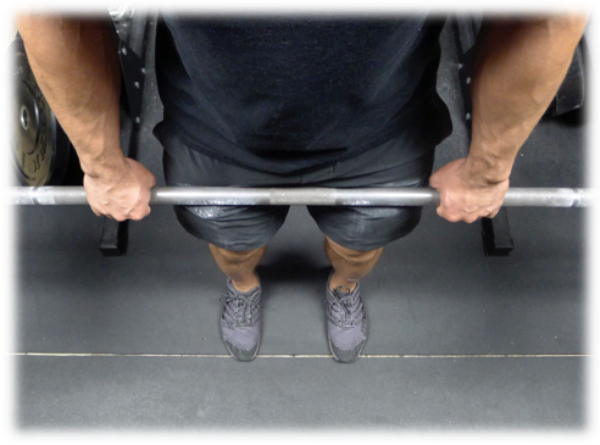
As you can see, the fingers and thumbs wrapped around the bar, and the palms are down, facing the shins.
This is a great grip for people new to deadlifting because it’s comfortable and distributes weight evenly between both sides of your body, allowing you to focus on learning the more technical aspects of the movement.
There’s a problem with the double overhand grip, though: It limits the amount of weight that you can pull.
At a certain point–about 1.5 times bodyweight, for most–your fingers are going to start giving out, causing the bar to roll out of your hands, and when that happens, force production comes to a screeching halt and you get stuck.
This is when most people move on from the double overhand, either by adding straps, or switching to the mixed grip.
Mixed Grip
The mixed grip is the double overhand grip with one hand flipped over, the palm facing away from the shins.
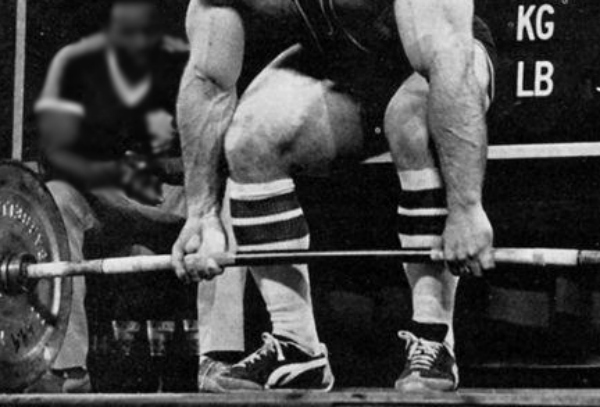
This is also called the “over-under grip,” and most people naturally find it most comfortable with their dominant hand facing their shins and non-dominant flipped.
The biggest benefit of the mixed grip is it allows you to securely hold a lot more weight than the double overhand grip because it prevents the bar from rolling out of your hands.
For example, I myself can’t pull more than about 400 pounds for a rep or two with a double overhand grip, but can, in the next set, go as high as the 430s for 4 to 5 reps with a mixed grip.
This works because when one hand begins to flag and the bar wants to roll, it just digs into the palm of the opposite hand, allowing it to remain stuck in place.
The mixed grip also has downsides, though.
- It makes you tend to rotate your torso toward your palm-down hand, creating a load imbalance between the left and right sides of your body.
- It places more strain on the biceps of your palm-up arm.
I don’t know of any scientific data on how this affects the safety of the exercise, but I’ll say this: while biceps tears are rare, when they do happen, it’s often the palm-up biceps during a mixed-grip deadlift.
Now, that isn’t to say that you should never use a mixed grip because you’re going to inevitably injure your biceps.
Instead, you can take a simple precaution to make the mixed grip safer: Alternate your grip in individual workouts or between them.
For example, I like to place my non-dominant (left) hand palm-down and my non-dominant hand palm-up for my first set or two, and then, for my next set or two, flip it around, placing my dominant hand palm-down and my non-dominant palm-up.
Another option is switching your grip workout to workout, placing your dominant hand palm-down in one session and then palm-up in the next, or vice versa.
Either way, this is a good way to prevent overuse on one side of your body and thus greatly reduce the chances of developing muscle imbalances or biceps strains or tears.
Hook Grip
If you’ve ever seen someone deadlift a tremendous amount of weight with what looks like a double overhand grip, you’ve witnessed the hook grip.
The reason you can’t tell them apart is they’re very similar, but with one crucial difference:
With the double overhand grip, your thumbs are wrapped around the bar. With the hook grip, though, your thumbs are placed sideways on the bar and your fingers are wrapped over them, like this:
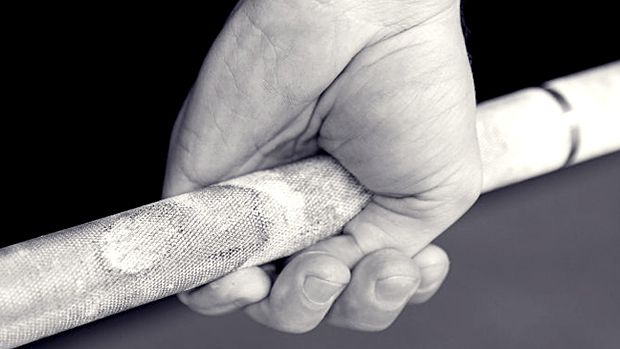
This allows you to lock the bar in place and prevent any rolling, and it has gained a lot of popularity in the powerlifting space as a viable alternative to both mixed grip and strapping.
It has a major drawback, though: It hurts. A lot.
Your thumbs get absolutely crushed by the load, so much so that the first time you pull a heavy load with a hook grip, you’ll probably think you’ve inflicted permanent nerve damage.
To that point, some people say it does just that–“deadening” the nerves in your thumbs over time–but the more likely explanation is you just build a tolerance to the pain.
The hook grip also makes it almost impossible to do more than a few reps without resetting your grip because your thumb is likely to slip out of your fingers as you descend.
Furthermore, it doesn’t work well for many women and men with smaller fingers because they can’t wrap them tightly enough around their thumbs, thereby compromising its primary mechanical advantage.
All this is why the hook grip is my least-favorite deadlift grip, and why I’d rather go with the double overhand grip with straps or mixed grip.
That said, the hook grip is best suited to powerlifters who aren’t comfortable using the mixed grip, because they aren’t allowed to use straps in competitions and thus have to learn how to hit personal records without help.
Double Overhand Grip with Straps
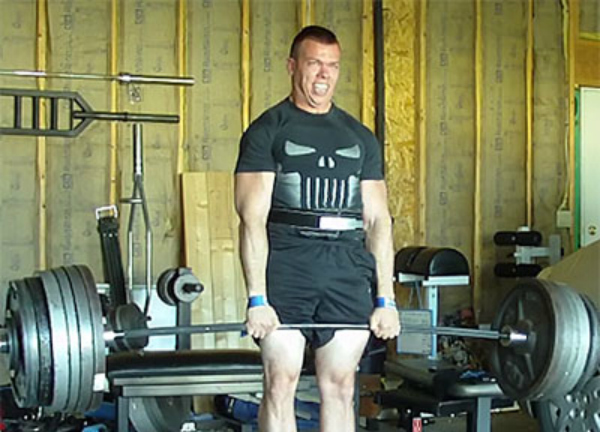
This deadlift grip is exactly what it sounds like:
The double overhand grip with assistance from cloth or leather straps.
Straps help by keeping the bar tight again your hands, preventing roll and allowing you to maintain a solid grip on it.
Now, many people shy away from straps because they look at it as a form of “cheating” and making the deadlift “easier.”
Well, while I wouldn’t advise someone new to weightlifting to strap from set one on, forever, I disagree that straps don’t have a place in any serious weightlifter’s bag.
When used properly, straps allow you to safely pull more weight (making the deadlift harder on the rest of your body, I might add) without any of the downsides of the mixed and hook grips.
They shouldn’t be necessarily viewed as a crutch, either.
Yes, some people do choose to use straps instead of developing their grip strength, but that doesn’t mean that everyone should avoid straps altogether.
Once you’ve gained a respectable amount of strength in the deadlift and drilled in correct form, there’s no reason why you shouldn’t choose straps over a mixed grip if you find it more comfortable.
If your biceps are taking a mighty beating with heavy mixed grip pulling, or you just prefer how the double overhand feels, then incorporating straps into your regimen makes sense. If, however, you do just fine with alternating a mixed grip and feel no need to change anything, then don’t.
Now, the keys to successful deadlift strapping are choosing the right straps, and using them when they’re actually needed.
Let’s take a closer look at each of these points, starting with the first: the types of straps to choose from.
1. The Single-Loop Strap
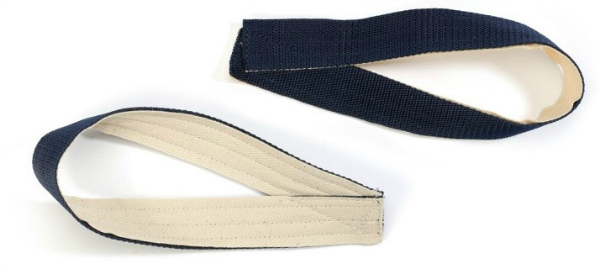
This is popular among Olympic lifters because it allows you to release the bar quickly, but it isn’t as comfortable or secure as other options for deadlifting.
Here’s how to use it:
2. The Figure 8 Strap
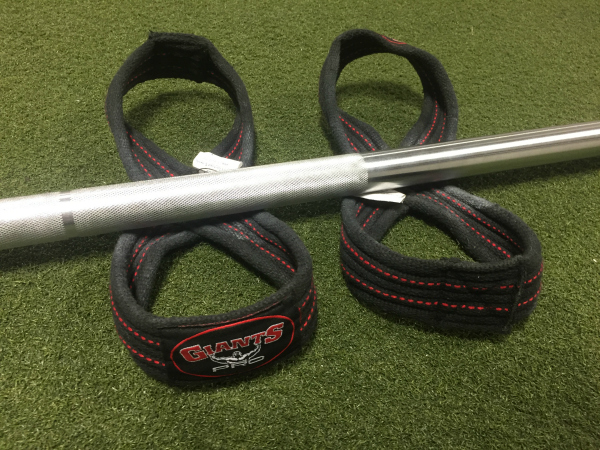
The figure 8 strap is made especially for deadlifting, basically tying your hands to the bar.
This is the type of strap used in deadlift competitions, where behemoths of men do stuff like this:
Here’s how to use it properly:
The downsides to the figure 8 strap are that you can’t drop the bar and it doesn’t lend itself to other pulling exercises that can benefit from straps, like dumbbell rows.
3. The Lasso Strap
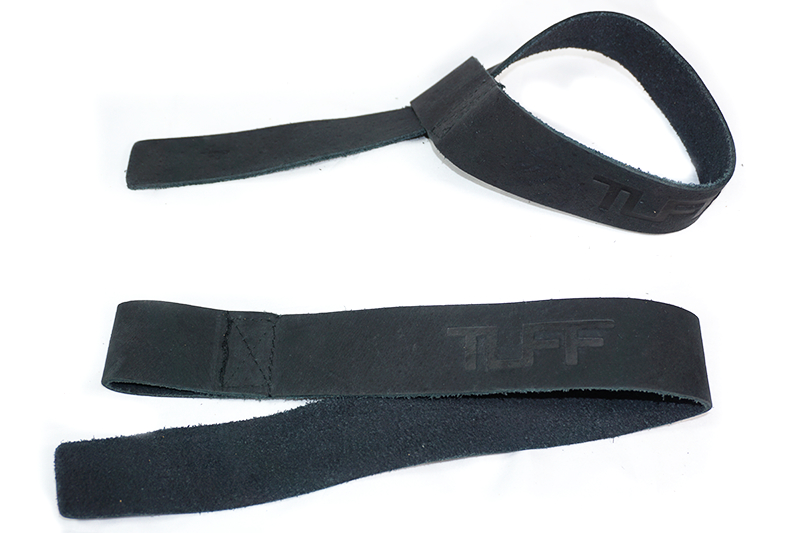
This is the most popular type of weightlifting strap, and it’s also what I like most.
It consists of a single strip of cloth or leather that you can loop into a lasso shape and wrap around a bar or dumbbell, and here’s how to use it properly:
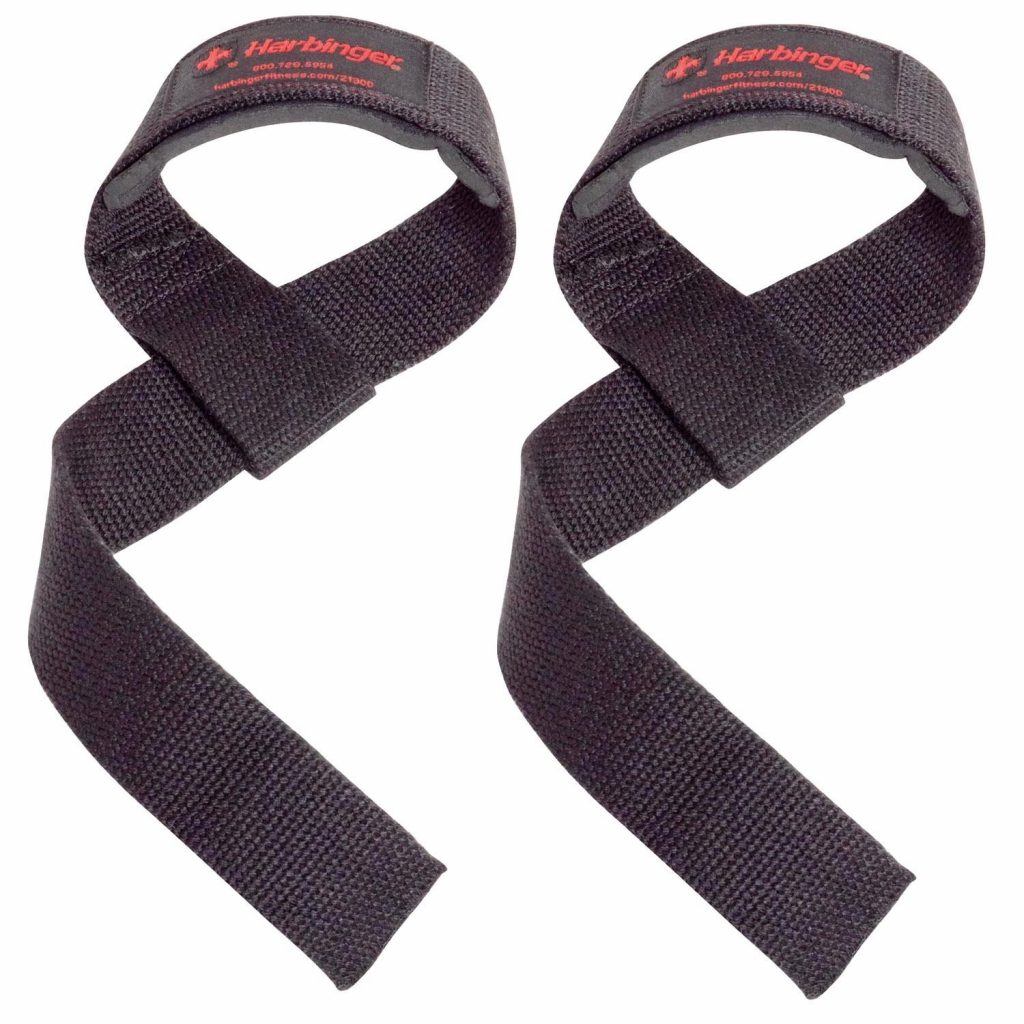
They’re cheap, durable, and versatile, and that’s all we really want from a strap.
A Simple Plan for Developing Your Deadlift Grip
Alright, we’ve now reviewed the basics of proper gripping, the different grip styles you can choose from, and how to pick the right straps.
Let’s now look at how to incorporate it all into your training.
1. If you’re new to deadlifting, start with a double overhand grip.
And stick with it until you’re having to abort heavy sets around the 5th or 6th rep due to grip failure.
2. Once you reach this point, use a double overhand grip for all warm-up sets and an alternating mixed grip for your heaviest working sets.
If your workout program includes lighter working sets, then stick with the strapless double overhand grip as these are a good opportunity to continue building forearm and grip strength.
3. Once you’re deadlifting more than twice your bodyweight, consider using straps on at least some of your heaviest working sets.
As I mentioned earlier, there’s nothing particularly wrong with sticking with an alternating mixed grip as you progress into heavier and heavier weights, but if you’re noticing high amounts of stress on your biceps, then you can use straps instead.
Personally, I like to use an alternating mixed grip for a few weeks of pulling, straps for the next few, and then back to mixed.
You can also include grip exercises in your routine at any point if you’re so inclined.
My favorite grip exercise is the plain ol’ barbell hold, which is exactly what it sounds like: holding onto a heavy barbell.
Here’s how to do and incorporate it into your program:
- Using a squat rack, place the bar at your knees and load it with a weight that you can hold for no more than 15 to 20 seconds.
- Do 3 sets of 15-to-20 second holds, resting for 3 minutes in between each set.
- Do this once or twice per week at the end of your workouts, separated by 2 to 3 days.
Last but not least, you can also use chalk for an easy boost in your double overhand and mixed grip strength.
Weightlifting chalk helps by absorbing sweat and increasing the friction between your palm and the bar, and you can go with the liquid variety if you don’t want to make a mess or your gym doesn’t allow it.
The Bottom Line on Improving Deadlift Grip
The single best way to improve your grip strength is to deadlift heavy weights.
So long as you focus on progressive overload in your pulling, your grip will improve accordingly.
If you’re like most people, though, your whole-body strength will eventually outpace your double overhand grip, and that’s when you need to give some thought as to how you move forward.
Fortunately, all you have to do is follow the plan outlined in this article and your grip will never get in the way of your gains.
Give it a try and you might be surprised at how strong you really are!









